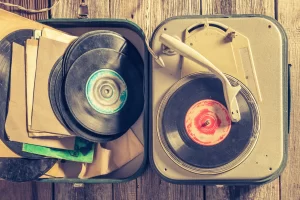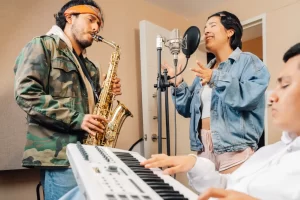DJing is a sophisticated art form that has evolved significantly over the years, redefining the boundaries of music and performance. At its core, DJing revolves around the seamless blending of different music tracks to create a continuous flow of rhythm and melody that can captivate an audience. This blog post aims to provide a comprehensive guide to the art of DJing, with a particular focus on two essential techniques: mixing and scratching.
Mixing involves beatmatching two or more songs to create a smooth transition, a skill that requires a keen ear and precise timing. Scratching, on the other hand, is a technique that manipulates the sound produced by a vinyl record on a turntable, adding a unique texture to the mix. Both these techniques have been instrumental in shaping the identity and aesthetics of DJing.
From the discotheques of the 70s to the digital platforms of today, DJing has transformed from a mere hobby into a professional career for many. It’s not just about playing one song after another; it’s about creating a musical narrative that can take listeners on a journey. Whether you’re an aspiring DJ or a music enthusiast interested in the technicalities behind those captivating beats, this guide will offer valuable insights into the intriguing world of DJing.
Let’s dive into the pulsating world of beats, rhythms, and scratches, and explore the fascinating art of DJing.
The History of DJing
The history of DJing is a fascinating journey that mirrors the evolution of music and technology. The term ‘DJ’, short for Disc Jockey, was first coined in the 1930s when radio announcers would introduce phonograph records played on the air. But the art form that we recognize as DJing today truly began in the late 1960s and early 1970s.
In the disco era of the 1970s, DJs like Francis Grasso pioneered beatmatching, the technique of aligning the beats of two different songs to create a seamless transition. This marked a significant shift in DJing as it allowed for continuous music play without breaks, keeping the dance floor alive and energized.
Meanwhile, in the Bronx, a whole new style of DJing was emerging. DJ Kool Herc, now known as the father of hip-hop, introduced the technique of using two copies of the same record to extend the break, the instrumental portion of the song that dancers loved. This became the foundation for breakdancing and later, for scratching, a technique popularized by Grandmaster Flash.
With the advent of digital technology in the late 20th century, DJing underwent another transformation. Digital software allowed for more precise mixing, while also making DJing more accessible to a broader audience.
Today, DJing is a respected art form and a professional career. DJs are not just background figures at parties; they are artists, producers, and performers in their own right. They shape musical trends and influence popular culture. And as we move forward, it’s exciting to think about how DJing will continue to evolve, pushing the boundaries of music and performance.
The Basics of Mixing
Mastering the basics of mixing is the first crucial step on the journey to becoming a skilled DJ. The essence of mixing lies in creating a seamless transition between two or more tracks, forming a continuous musical experience that keeps the audience engaged.
The cornerstone of mixing is beatmatching, a technique that involves synchronizing the beats of two different tracks. This requires adjusting the tempo of the incoming track to match the beat of the currently playing one, ensuring that the rhythm remains consistent as you transition from one song to the next. While this may sound simple, it requires a keen sense of rhythm and an in-depth understanding of music structure.
Once you’ve mastered beatmatching, the next step is blending the tracks. This involves using the mixer’s crossfader to gradually introduce the incoming track while simultaneously fading out the current one. This should be done in a way that the transition is smooth and almost unnoticeable.
Equalization (EQing) is another key aspect of mixing. Each track has its own unique sonic profile, with different levels of bass, midrange, and treble. Adjusting these EQ levels can help you blend tracks more effectively, preventing frequency clashes and ensuring a balanced sound output.
Lastly, it’s crucial to remember that mixing is not just a technical skill, but also an artistic one. The choice of tracks, the timing of transitions, and the manipulation of sounds all play a part in creating a unique mix. It’s about knowing your music, understanding your audience, and crafting a musical journey that resonates with listeners.
Remember, like any art form, mastering the basics of mixing takes time and practice. So don’t be disheartened by initial challenges. Keep experimenting, keep learning, and most importantly, keep enjoying the process.
The Art of Scratching
The art of scratching is a significant aspect of DJing that adds a unique flavor to the mix. Originating in the hip-hop scene of the 1970s, scratching has become an essential technique that DJs across various genres incorporate into their sets to create dynamic and engaging performances.
Simply put, scratching involves moving a vinyl record back and forth on a turntable while the stylus is in the groove, creating rhythmic sounds. However, it’s not just about the physical movement; it’s about timing, precision, and musicality.
There are several types of scratches, each with its own unique sound and complexity. The “baby scratch” is the most basic form, involving moving the record back and forth without using the crossfader. As you progress, you can learn more complex techniques like the “chirp,” “flare,” or “crab,” which involve intricate hand movements and precise crossfader control.
While scratching is traditionally associated with vinyl records and turntables, modern digital DJ equipment also allows for scratching. Many DJ controllers and CDJs have jog wheels that mimic the feel of a vinyl record, enabling DJs to scratch digitally.
It’s important to note that scratching is an expressive tool. It’s not just about making noise; it’s about adding to the musical narrative. A well-executed scratch can accentuate the rhythm, create tension, or add a playful element to the mix.
Mastering the art of scratching requires practice and patience. It’s a skill that takes time to develop, but once mastered, it can significantly enhance your DJing style and performance. So, get your hands on those decks, and let the scratching begin!
Essential DJ Equipment
Embarking on your journey as a DJ requires an understanding of the essential equipment that forms a DJ’s toolkit. This equipment helps to create, manipulate, and amplify music to captivate audiences.
Firstly, at the heart of any DJ setup are the decks. Traditionally, these were turntables used to play vinyl records. However, in the digital age, DJs often use CDJs (compact disc jockeys) or DJ controllers that play digital music files via DJ software. These devices allow for track manipulation, including beatmatching, looping, and scratching.
Next is a DJ mixer, a device that blends the audio from two or more decks. It features volume controls, equalizers for adjusting bass, mid-range, and treble frequencies, and a crossfader for transitioning between tracks. Some mixers also have built-in effects like echo or reverb for added creativity.
Headphones are another piece of essential DJ equipment. They allow DJs to cue up tracks privately before introducing them into the mix, ensuring smooth transitions. Look for closed-back headphones with good sound isolation to block out external noise.
Speakers, or PA systems, are necessary for amplifying the sound for an audience. The size and power of the speakers will depend on the venue size and the number of people in the audience.
Finally, don’t forget about the music itself. Whether you’re using vinyl, CDs, or digital files, you’ll need a well-organized library of tracks. This includes knowing your music well, categorizing it effectively, and constantly updating your collection with fresh tunes.
Remember, how you use the equipment is what truly defines your ability as a DJ. Mastering your gear, understanding its capabilities, and using it creatively is what will set you apart.
Tips and Tricks for Aspiring DJs
For aspiring DJs, diving into the world of mixing and scratching can be both exciting and daunting. Here are some tips and tricks that can help you navigate this journey effectively.
Master the Basics: Before you start experimenting with advanced techniques, make sure you have a solid understanding of the basics. This includes beatmatching, EQing, and track selection. Practice these skills until they become second nature.
Know Your Music: An effective DJ is not just a performer but also a music connoisseur. Spend time curating and organizing your music library. Familiarize yourself with different genres, artists, and tracks. The more you know your music, the better you’ll be at selecting the right track for any given moment.
Read the Crowd: DJing is about creating a musical journey that resonates with your audience. Pay attention to how the crowd reacts to different tracks and adjust your set accordingly. Remember, your role is to keep the dance floor moving!
Experiment and Innovate: Don’t be afraid to step out of your comfort zone. Try new techniques, play with different genres, and create unique mixes. Innovation is what sets great DJs apart.
Invest in Quality Equipment: While it’s possible to start DJing with minimal gear, investing in quality equipment can enhance your performance. This doesn’t necessarily mean the most expensive gear, but rather equipment that is reliable, suits your style, and delivers good sound quality.
Network: Connect with other DJs and industry professionals. Attend gigs, join online DJ communities, and engage in discussions. Networking can open up opportunities and provide valuable insights.
Keep Learning: The world of DJing is constantly evolving, with new technologies and techniques emerging regularly. Stay updated, keep learning, and continually refine your skills.
Becoming a successful DJ takes time, patience, and plenty of practice. So, stay dedicated, keep the music playing, and most importantly, enjoy the journey!
Profiles of Noteworthy DJs
The world of DJing is filled with individuals who have pushed boundaries, innovated, and left an indelible mark on the music industry. Let’s take a look at some noteworthy DJs who have significantly influenced this art form.
Grandmaster Flash: Considered one of the pioneers of DJing, Grandmaster Flash was instrumental in the development of hip-hop in the late 70s and early 80s. He is renowned for his innovative mixing techniques and for inventing the ‘Quick Mix Theory’, which incorporated quick sampling and scratching of records.
Carl Cox: A titan in the world of electronic dance music, Carl Cox has been spinning records since the 1980s. Known for his infectious energy and seamless three-deck mixing, he’s been a mainstay in the global techno scene and continues to captivate audiences worldwide.
DJ Jazzy Jeff: Renowned for his collaboration with Will Smith (The Fresh Prince), DJ Jazzy Jeff has made significant contributions to the DJ industry. His inventive scratching techniques have earned him respect among peers and fans alike.
Tiësto: Recognized as one of the greatest DJs of all time, Tiësto has played a pivotal role in bringing electronic dance music into the mainstream. His ability to create epic, energetic sets has seen him headline major music festivals across the globe.
Nina Kraviz: As one of the leading female figures in the world of techno, Nina Kraviz has carved out a unique space for herself in the industry. Her eclectic track selection and hypnotic mixing style have garnered her a dedicated following.
David Guetta: Known for his fusion of electronic music with pop, David Guetta has achieved colossal mainstream success. His collaborations with top artists from various genres have resulted in chart-topping hits and have helped bring DJing to a wider audience.
These DJs, each with their unique styles and contributions, have shaped the landscape of DJing. They serve as inspirations for aspiring DJs, demonstrating the power of creativity, innovation, and passion in the art of DJing.
To Sum It Up
DJing is a fascinating blend of art and technology, requiring a deep understanding of music, technical skill, creativity, and the ability to connect with an audience. It’s a journey that begins with mastering essential DJ equipment, from decks and mixers to headphones and PA systems. Aspiring DJs must spend time honing their skills, understanding their music, reading their audience, and continually learning and experimenting.
Yet, as we’ve seen from the profiles of noteworthy DJs such as Grandmaster Flash, Carl Cox, DJ Jazzy Jeff, Tiësto, Nina Kraviz, and David Guetta, there’s no one path to success in DJing. Each of these artists has brought their unique style and innovations to the craft, pushing boundaries and shaping the industry in significant ways.
As an aspiring DJ, take inspiration from these pioneers but also strive to find your unique voice and style. DJing is about more than just playing music; it’s about creating experiences, telling stories through sound, and moving people both literally and emotionally.
Remember, success in this field doesn’t come overnight. It requires dedication, patience, and a genuine love for music. But with passion and perseverance, you too can leave your mark on the world of DJing. So, whether you’re spinning vinyl in your bedroom or digital tracks on a festival stage, keep the music playing and let your DJ journey unfold.




